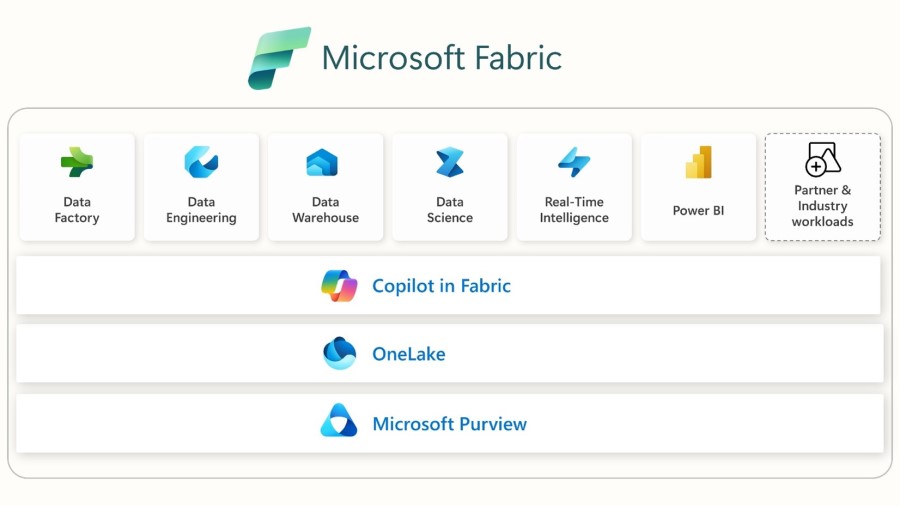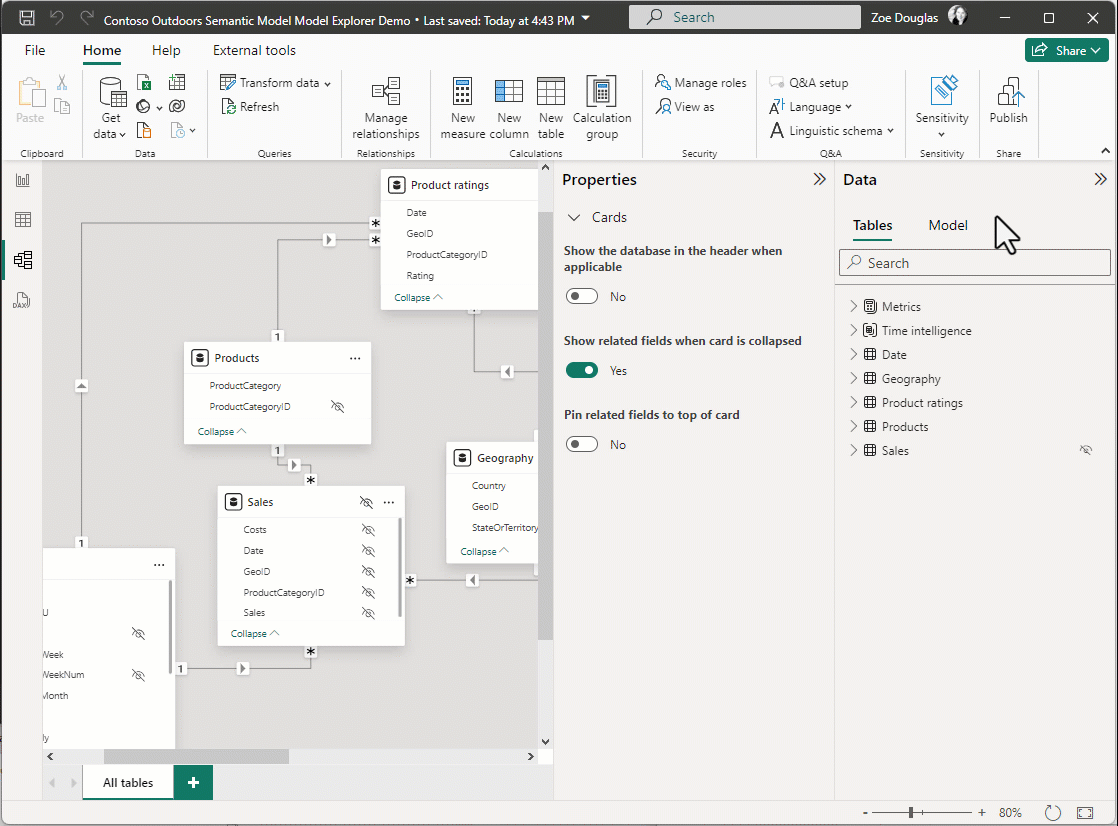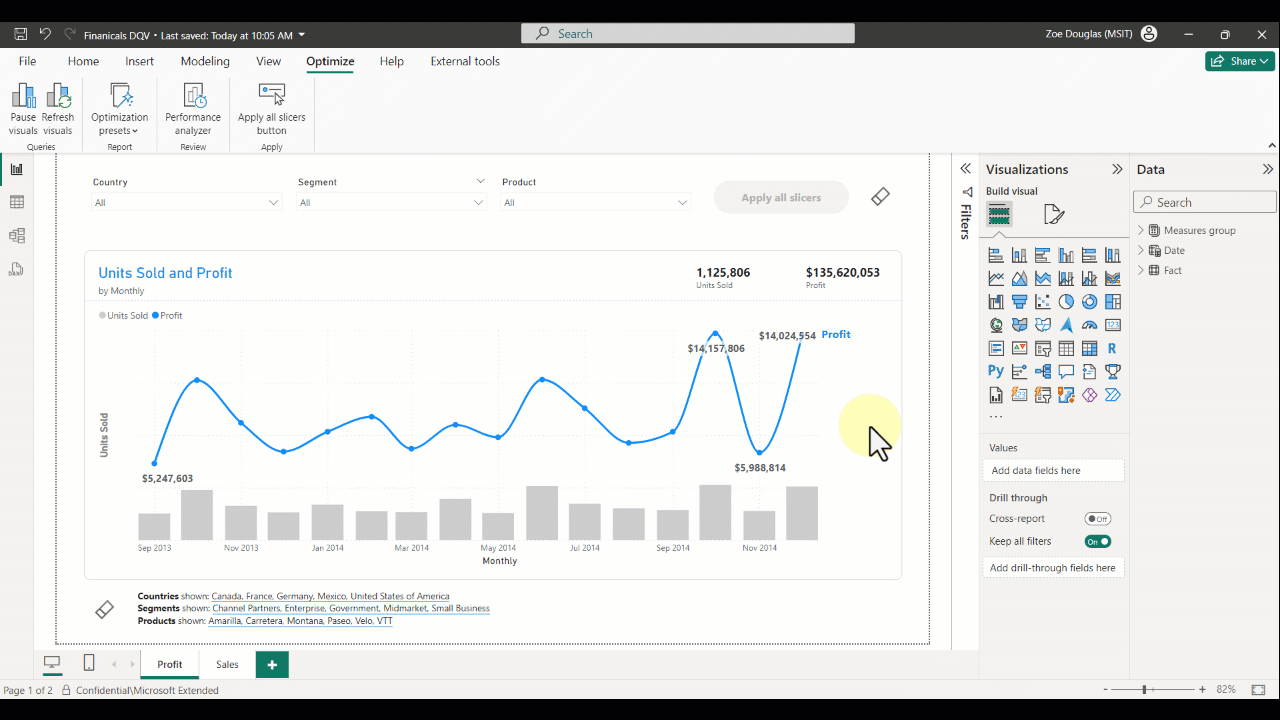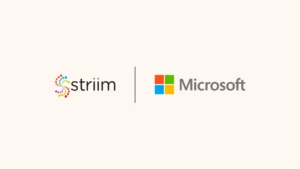
Unlock real-time insights with AI-powered analytics in Microsoft Fabric
The data and analytics landscape is changing faster than ever. From the emergence of generative AI to the proliferation of citizen analysts to the increasing importance of real-time, autonomous action, keeping up with the latest trends can feel overwhelming. Every trend requires new services that customers must manually stitch into their data estate—driving up both cost and complexity.
With Microsoft Fabric, we are simplifying and future-proofing your data estate with an ever-evolving, AI-powered data analytics platform. Fabric will keep up with the trends for you and seamlessly integrate each new capability so you can spend less time integrating and managing your data estate and more time unlocking value from your data.
Get started with Microsoft Fabric
Set up Fabric for your business and discover resources that help you take the first steps

Aurizon, Australia’s largest rail freight operator, turned to Fabric to modernize their data estate and analytics system.
“With Microsoft Fabric, we’ve answered many of our questions about navigating future growth, to remove legacy systems, and to streamline and simplify our architecture. A trusted data platform sets us up to undertake complex predictive analytics and optimizations that will give greater surety for our business and drive commercial benefits for Aurizon and our customers in the very near future.”
—Tammy Wigg, Chief Data Analytics Officer at Aurizon
Aurizon is just one among thousands of customers who have already used Fabric to revolutionize how they connect to and analyze their data. In fact, a 2024 commissioned Total Economic Impact™ (TEI) study conducted by Forrester Consulting found that Microsoft Fabric customers saw a three-year 379% return on investment (ROI) with a payback period of less than six months. We are thrilled to share a huge range of new capabilities coming to Fabric. These innovations will help you more effectively uncover insights and keep you at the forefront of the trends in data and analytics. Check out a quick overview of the biggest changes coming to Fabric.
Fabric is a complete data platform
Prepare your data for AI innovation with Microsoft Fabric—now generally available
Read the blogFabric is a complete data platform—giving your data teams the ability to unify, transform, analyze, and unlock value from data from a single, integrated software as a service (SaaS) experience. We are excited to announce additions to the Fabric workloads that will make Fabric’s capabilities even more robust and even customizable to meet the unique needs of each organization. These enhancements include:
- A completely redesigned workload, Real-Time Intelligence, that brings together and enhances Synapse Real-Time Analytics and Data Activator to help you analyze and act on high-volume, high-granular event streaming data and even explore your organization’s real-time data in the new Real-time hub.
- New tools like the Fabric Workload Development Kit, Application Programming Interface (API) for GraphQL™, and “user data functions” that can help developers build powerful solutions on the Fabric platform.
- A new feature in the Microsoft Azure Data Factory experience called Data workflow, powered by Apache Airflow runtime, that can help you author, schedule, and monitor workflows or data pipelines using Python.

Unlock continuous insights with Real-Time Intelligence and the Real-time hub
When we introduced Fabric, it launched with seven core workloads which included Synapse Real-time Analytics for data streaming analysis and Data Activator for monitoring and triggering actions in real-time. We are unveiling an enhanced workload called Real-Time Intelligence that combines these workloads and brings an array of additional new features, in preview, to help organizations make better decisions with up-to-the-minute insights. From ingestion to transformation, querying, and taking immediate action, Real-Time Intelligence is an end-to-end experience that enables seamless handling of real-time data without the need to land it first. With Real-Time Intelligence, you can ingest streaming data with high granularity, dynamically transform streaming data, query data in real-time for instant insights, and trigger actions like alerting a production manager when equipment is overheating or rerunning jobs when data pipelines fail. And with both simple, low-code or no-code, and powerful, code-rich interfaces, Real-Time Intelligence empowers every user to work with real-time data.
Behind this powerful workload is the Real-time hub, a single place to discover, manage, and use event streaming data from Fabric and other data sources from Microsoft, third-party cloud providers, and other external data sources. Just like the OneLake data hub makes it easy to discover, manage, and use the data at rest, the Real-time hub can help you do the same for data in motion. All events that flow through the Real-time hub can be easily transformed and routed to any Fabric data store and users can create new streams that can be discovered and consumed. From the Real-time hub, users can gain insights through the data profile, configure the right level of endorsement, set alerts on changing conditions and more, all without leaving the hub. While the existing Real-Time Analytics capabilities are still generally available, the Real-time hub and the other new capabilities coming to the Real-Time Intelligence workload are currently in preview. Watch this demo video to check out the redesigned Real-Time Intelligence experience:
Elcome, one of the world’s largest marine electronics companies, built a new service on Fabric called “Welcome” that helps maritime crews stay connected to their families and friends.
Microsoft Fabric Real-Time Intelligence has been the essential building block that’s enabled us to monitor, manage, and enhance the services we provide. With the help of the Real-time hub for centrally managing data in motion from our diverse sources and Data Activator for event-based triggers, Fabric’s end-to-end cloud solution has empowered us to easily understand and act on high-volume, high-granularity events in real-time with fewer resources.”
—Jimmy Grewal, Managing Director of Elcome
Real-time insights are becoming increasingly critical across industries like route optimization in transportation and logistics, grid monitoring in energy and utilities, predictive maintenance in manufacturing, and inventory management in retail. And since Real-Time Intelligence comes fully optimized and integrated in a SaaS platform, adoption is seamless. Strathan Campbell, Channel Environment Technology Lead at One NZ—the largest mobile carrier in New Zealand—said they “…went from a concept to a delivered product in just two weeks.” To learn more about the Real-Time Intelligence workload, watch the “Ingest, analyze and act in real time with Microsoft Fabric” Microsoft Build session or read the Real-Time Intelligence blog.
Extend Fabric with your own, custom workloads and experiences
Fabric was built from the ground up to be extensible, customizable, and open. Now, we are making it even easier for software developers and customers to design, build, and interoperate applications within Fabric with the new Fabric Workload Development Kit—currently in preview. Applications built with this kit will appear as a native workload within Fabric, providing a consistent experience for users directly in their Fabric environment without any manual effort. Software developers can publish and monetize their custom workloads through Azure Marketplace. And, coming soon, we are creating a workload hub experience in Fabric where users can discover, add, and manage these workloads without ever leaving the Fabric environment. We already have industry-leading partners building on Fabric including SAS, Esri, Informatica, Teradata, and Neo4j.
You can also learn more about the Workload Development Kit by watching the “Extend and enhance your analytics applications with Microsoft Fabric” Microsoft Build session.
We are also excited to announce two new features, both in preview, created with developers in mind: API for GraphQL and user data functions in Fabric. API for GraphQL is a flexible and powerful RESTful API that allows data professionals to access data from multiple sources in Fabric with a single query API. With API for GraphQL, you can streamline requests to reduce network overheads and accelerate response rates. User data functions are user-defined functions built for Fabric experiences across all data services, such as notebooks, pipelines, or event streams. These features enable developers to build experiences and applications using Fabric data sources more easily like lakehouses, data warehouses, mirrored databases, and more with native code ability, custom logic, and seamless integration. You can watch these features in action in the “Introducing API for GraphQL and User Data Functions in Microsoft Fabric” Microsoft Build session.
You can also learn more about the Workload Development Kit, the API for GraphQL, user data functions, and more by reading the Integrating ISV apps with Microsoft Fabric blog.
Orchestrate complex data workflows in the Fabric Data Factory workload
We are also announcing the preview of Data workflows in Fabric as part of the Data Factory experience. Data workflows allow customers to define Directed Acyclic Graphs (DAG) files for complex data workflow orchestration in Fabric. Data workflows is powered by the Apache Airflow runtime and designed to help you author, schedule and monitor workflows or data pipelines using python. Learn more by reading the data workflows blog.
Fabric is lake-centric and open
The typical data estate has grown organically over time to span multiple clouds, accounts, databases, domains, and engines with a multitude of vendors and specialized services. OneLake, Fabric’s unified, multi-cloud data lake built to span an entire organization, can connect to data from across your data estate and reduce data duplication and sprawl.
We are excited to announce the expansion of OneLake shortcuts to connect to data from on-premises and network-restricted data sources beyond just Azure Data Lake Service Gen2, now in preview. With an on-premises data gateway, you can now create shortcuts to Google Cloud Storage, Amazon S3, and S3 compatible storage buckets that are either on-premises or otherwise network-restricted. To learn more about these announcements, watch the Microsoft Build session “Unify your data with OneLake and Microsoft Fabric.”
Empower business users with Fabric
Insights drive impact only when they reach those who can use them to inform actions and decisions. Professional and citizen analysts bridge the gap between data and business results, and with Fabric, they have the tools to quickly manage, analyze, visualize, and uncover insights that can be shared with the entire organization. We are excited to help analysts work even faster and more effectively by releasing the model explorer and the DAX query view in Microsoft Power BI Desktop into general availability.
The model explorer in Microsoft Power BI provides a rich view of all the semantic model objects in the data pane—helping you find items in your data fast. You can also use the model explorer to create calculation groups and reduce the number of measures by reusing calculation logic and simplifying semantic model consumption.

The DAX query view in Power BI Desktop lets users discover, analyze, and see the data in their semantic model using the DAX query language. Users working with a model can validate data and measures without having to build a visual or use an additional tool—similar to the Explore feature. Changes made to measures can be seamlessly updated directly back to the semantic model.

To learn more about these announcements and others coming to Power BI, check out the Power BI blog.
Fabric is AI-powered
When ChatGPT was launched, it had over 100 million users in just over two months—the steepest adoption curve in the history of technology.1 It’s been a year and a half since that launch, and organizations are still trying to translate the benefit of generative AI from novelty to actual business results. By infusing generative AI into every layer of Fabric, we can empower your data professionals to employ its benefits, in the right context and in the right scenario to get more done, faster.
Use Copilot in Fabric, now generally available
Copilot in Fabric was designed to help users unlock the full potential of their data by assisting data professionals to be more productive and business users to explore their data more easily. With Copilot in Fabric, you can use conversational language to create dataflows, generate code and entire functions, build machine learning models, or visualize results. We are excited to share that Copilot in Fabric is now generally available, starting with the Power BI experience. This includes the ability to create stunning reports and summarize your insights into narrative summaries in seconds. Copilot in Fabric is also now enabled on-by-default for all eligible tenants including Copilot in Fabric experiences for Data Factory, Data Engineering, Data Science, Data Warehouse, and Real-Time Intelligence, which are all still in preview. The general availability of Copilot in Fabric for the Power BI experience will be rolling out over the coming weeks to all customers with Power BI Premium capacity (P1 or higher) or Fabric capacity (F64 or higher).
We are also thrilled to announce a new Copilot in Fabric experience for Real-Time Intelligence, currently in preview, that enables users to explore real-time data with ease. Starting with a Kusto Query Language (KQL) Queryset connected to a KQL Database in an Eventhouse or a standalone Azure Data Explorer database, you can type your question in conversational language and Copilot will automatically translate it to a KQL query you can execute. This experience is especially powerful for users less familiar with writing KQL queries but still want to get the most from their time-series data stored in Eventhouse.
Create custom Q&A experiences with your data with AI skills
We are also thrilled to release a new AI capability in preview called AI skills—an innovative experience designed to provide any user with a conversational Q&A experience about their data. AI skills allow you to simply select the data source in Fabric you want to explore and immediately start asking questions about your data—even without any configuration. When answering questions, the generative AI experience will show the query it generated to find the answer and you can enhance the Q&A experience by adding more tables, setting additional context, and configuring settings. AI skills can empower everyone to explore data, build and configure AI experiences, and get the answers and insights they need.
AI skills will honor existing security permissions and can be configured to respect the unique language and nuances of your organization, ensuring that responses are not just data-driven but steeped in the context of your business operations. And, coming soon, it can also enrich the creation of new copilots in Microsoft Copilot Studio and be interacted with from Copilot for Microsoft for 365. It’s about making your data not just accessible but approachable, inviting users to explore insights through natural dialogue, and shortening the time to insight.
New partnerships with Microsoft Fabric
Snowflake and Microsoft Fabric
With the launch of Fabric, we’ve committed to open data formats, standards, and interoperability with our partners to give our customers the flexibility to do what makes sense for their business. We are taking this commitment a step further by expanding our existing partnership with Snowflake to expand interoperability between Snowflake and Fabric’s OneLake. We are excited to announce future support for Apache Iceberg in Fabric OneLake and bi-directional data access between Snowflake and Fabric. This integration will enable users to analyze their Fabric and Snowflake data written in Iceberg format in any engine within either platform, and access data across apps like Microsoft 365, Microsoft Power Platform, and Microsoft Azure AI Studio.
With the upcoming availability of shortcuts for Iceberg in OneLake, Fabric users will be able to access all data sources in Iceberg format, including the Iceberg sources from Snowflake, and translate metadata between Iceberg and Delta formats. This means you can work with a single copy of your data across Snowflake and Fabric. Since all the OneLake data can be accessed in Snowflake as well as in Fabric, this integration will enable you to spend less time stitching together applications and your data estate, and more time uncovering insights. To learn more about this announcement, read the Fabric and Snowflake partnership blog.
Adobe and Microsoft Fabric
We are also excited to announce we are expanding our existing relationship with Adobe. Adobe Experience Platform (AEP) and Adobe Campaign will have the ability to federate enterprise data from Fabric. Our joint customers will soon have the capability to connect to Fabric and use the Fabric Data Warehouse for query federation to create and enrich audiences for engagement, without having to transfer or extract the data from Fabric.
Combine Fabric and Microsoft Azure Databricks to get the best of both worlds
We are excited to announce that we are expanding the integration between Fabric and Azure Databricks—allowing you to have a truly unified experience across both products and pick the right tools for any scenario.
Azure Databricks Unity Catalog integration with Fabric
Coming soon, you will be able to access Azure Databricks Unity Catalog tables directly in Fabric, making it even easier to unify Azure Databricks with Fabric. From the Fabric portal, you can create and configure a new Azure Databricks Unity Catalog item in Fabric with just a few clicks. You can add a full catalog, a schema, or even individual tables to link and the management of this Azure Databricks item in OneLake—a shortcut connected to Unity Catalog—is automatically taken care of for you.
This data acts like any other data in OneLake—you can write SQL queries or use it with any other workloads in Fabric including Power BI through Direct Lake mode. When the data is modified or tables are added, removed, or renamed in Azure Databricks, the data in Fabric will remain always in sync. This new integration makes it simple to unify Azure Databricks data in Fabric and seamlessly use it across every Fabric workload.
Federate OneLake as a Remote Catalog in Azure Databricks
Also coming soon, Fabric users will be able to access Fabric data items like lakehouses as a catalog in Azure Databricks. While the data remains in OneLake, you can access and view data lineage and other metadata in Azure Databricks and leverage the full power of Unity Catalog. This includes extending Unity Catalog’s unified governance over data and AI into Azure Databricks Mosaic AI. In total, you will be able to combine this data with other native and federated data in Azure Databricks, perform analysis assisted by generative AI, and publish the aggregated data back to Power BI—making this integration complete across the entire data and AI lifecycle.
Watch these announcements in action at Microsoft Build 2024
Join us at Microsoft Build from May 21 to 23, 2024 to see all of these announcements in action across the following sessions:
- “Microsoft Build opening keynote” with Satya Nadella, Kevin Scott, and Rajesh Jha.
- “Next generation AI for developers with the Microsoft Cloud” with Scott Guthrie.
- “Microsoft Fabric: What’s new and what’s next” with Arun Ulagaratchagan and Amir Netz.
- “Ingest, analyze and act in real time with Microsoft Fabric” with Yitzhak Kesselman and Tessa Kloster.
- “Extend and enhance your analytics applications with Microsoft Fabric” with Dipti Borkar and Teddy Bercovitz.
- Introducing API for GraphQL and User Data Functions in Microsoft Fabric” with Monica Boris and Dipti Borkar.
- “Unify your data with OneLake and Microsoft Fabric” with Josh Caplan and Charles Webb.
- “Accelerate insights with real-time Azure SQL Data and Microsoft Fabric” with Anna Hoffman and Bob Ward.
- “Intergrating Azure AI and Microsoft Fabric for Next-Gen AI Solutions” with Nellie Gustafsson and Facundo Santiago.
- “Activate enterprise data in AI-enabled business applications” with Rakesh Krishnan and Srikumar Nair.
You can also try out these new capabilities and everything Fabric has to offer yourself by signing up for a free 60-day trial—no credit card information required. To start your free trial, sign up for a free account (Power BI customers can use their existing account), and once signed in, select start trial within the account manager tool in the Fabric app. Existing Power BI Premium customers can already access Fabric by simply turning on Fabric in their Fabric admin portal. Learn more on the Fabric get started page.
Join us at the European Microsoft Fabric Community Conference
We are excited to announce a European Microsoft Fabric Community Conference that will be held in Stockholm, Sweden from September 23 to 26, 2024. You can see firsthand how Fabric and the rest of the data and AI products at Microsoft can help your organization prepare for the era of AI. You will hear from leading Microsoft and community experts from around the world and get hands on experiences with the latest features from Fabric, Power BI, Azure Databases, Azure AI, Microsoft Purview, and more. You will also have the opportunity to learn from top data experts and AI leaders while having the chance to interact with your peers and share your story. We hope you will join us and see how cutting-edge technologies from Microsoft can enable your business success with the power of Fabric.
Explore additional resources for Microsoft Fabric
If you want to learn more about Microsoft Fabric:
- Sign up for the Microsoft Fabric free trial.
- View the updated Microsoft Fabric Roadmap.
- Visit the Microsoft Fabric website.
- Join the Fabric community.
- Read about other Azure announcements:
- Read other in-depth, technical blogs on the Microsoft Fabric Updates Blog.
- Read the new Microsoft Fabric security whitepaper.
- Watch the Real-Time Intelligence Microsoft Mechanics video.
- Explore the Fabric technical documentation.

1ChatGPT sets record for fastest-growing user base – analyst note, Reuters.




